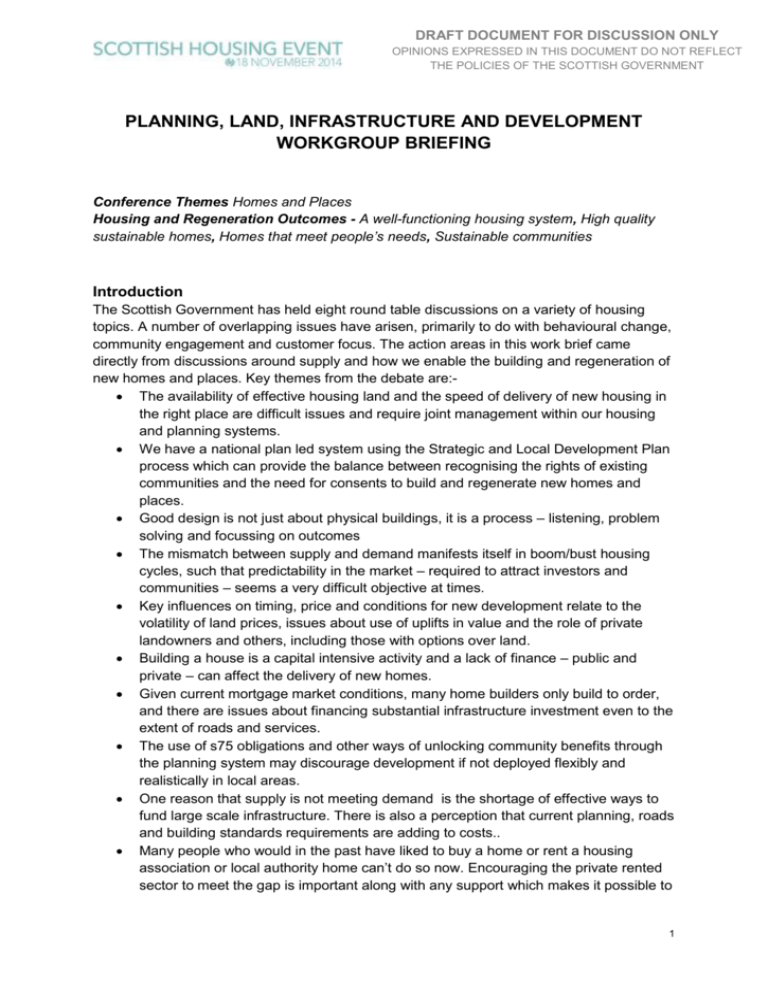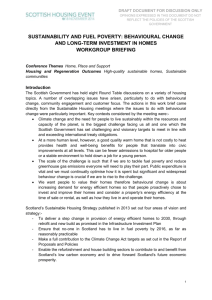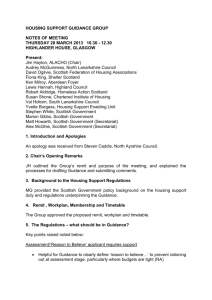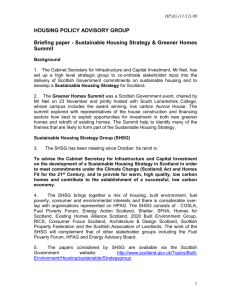Open - The Scottish Government
advertisement

DRAFT DOCUMENT FOR DISCUSSION ONLY OPINIONS EXPRESSED IN THIS DOCUMENT DO NOT REFLECT THE POLICIES OF THE SCOTTISH GOVERNMENT PLANNING, LAND, INFRASTRUCTURE AND DEVELOPMENT WORKGROUP BRIEFING Conference Themes Homes and Places Housing and Regeneration Outcomes - A well-functioning housing system, High quality sustainable homes, Homes that meet people’s needs, Sustainable communities Introduction The Scottish Government has held eight round table discussions on a variety of housing topics. A number of overlapping issues have arisen, primarily to do with behavioural change, community engagement and customer focus. The action areas in this work brief came directly from discussions around supply and how we enable the building and regeneration of new homes and places. Key themes from the debate are: The availability of effective housing land and the speed of delivery of new housing in the right place are difficult issues and require joint management within our housing and planning systems. We have a national plan led system using the Strategic and Local Development Plan process which can provide the balance between recognising the rights of existing communities and the need for consents to build and regenerate new homes and places. Good design is not just about physical buildings, it is a process – listening, problem solving and focussing on outcomes The mismatch between supply and demand manifests itself in boom/bust housing cycles, such that predictability in the market – required to attract investors and communities – seems a very difficult objective at times. Key influences on timing, price and conditions for new development relate to the volatility of land prices, issues about use of uplifts in value and the role of private landowners and others, including those with options over land. Building a house is a capital intensive activity and a lack of finance – public and private – can affect the delivery of new homes. Given current mortgage market conditions, many home builders only build to order, and there are issues about financing substantial infrastructure investment even to the extent of roads and services. The use of s75 obligations and other ways of unlocking community benefits through the planning system may discourage development if not deployed flexibly and realistically in local areas. One reason that supply is not meeting demand is the shortage of effective ways to fund large scale infrastructure. There is also a perception that current planning, roads and building standards requirements are adding to costs.. Many people who would in the past have liked to buy a home or rent a housing association or local authority home can’t do so now. Encouraging the private rented sector to meet the gap is important along with any support which makes it possible to 1 DRAFT DOCUMENT FOR DISCUSSION ONLY OPINIONS EXPRESSED IN THIS DOCUMENT DO NOT REFLECT THE POLICIES OF THE SCOTTISH GOVERNMENT build new homes while balancing planning for assets that will be with us for at least 100 years. Policy Links Homes fit for the 21st Century http://www.scotland.gov.uk/publications/2011/02/03132933/0 Planning http://www.scotland.gov.uk/Resource/0045/00453827.pdf Place making http://www.scotland.gov.uk/Publications/2013/06/9811/5 Land Reform Review Group http://www.scotland.gov.uk/Resource/0045/00451087.pdf RICS Report http://www.rics.org/uk/about-rics/what-we-do/influencing-policy/influencingactivity/thought-leadership-papers/the-rics-scottish-housing-commission-report-building-abetter-scotland/ Audit Scotland Report http://www.auditscotland.gov.uk/docs/local/2013/nr_130711_housing_overview.pdf Action Area One - How can planners, developers and public sector providers improve effective long term planning for housing and people and the design of places and communities ? Do public and private agencies need to give master planning for whole communities, as part of the development plan process, the same priority as designing the type, tenure and quality of housing provided in planning applications ? What lessons can we learn from the Scottish Sustainable Communities Initiative to build on ? Are public and private sectors working effectively together and how can we jointly identify improvements ? Action Area Two - Do we have a well- functioning, effective, housing land supply in Scotland ? A current Scottish Government led working group is looking at the 2010 definition of effectiveness to ensure that sites in development plans are deliverable. What factors need to be taken into account to get to an agreed definition of effective land between the public and private sectors ? Action Area Three - How can public and private interests work more collaboratively in land assembly and site development measures ? Can we jointly collaborate on the unlocking of brownfield sites and public sector assets to deliver housing land in the places that it is needed ? Measures to accelerate development of housing land may include tax incentives, penalties for non-development within realistic timescales, or more use of Compulsory Purchase Orders. What else can the public and private sectors do to accelerate more sites into development ? Action Area Four – How do we promote site specific housing investment action plans to ensure viable proposals to develop housing sites ? Action plans linked to development plans could identify realistic resources to deliver proposed housing projects. 2 DRAFT DOCUMENT FOR DISCUSSION ONLY OPINIONS EXPRESSED IN THIS DOCUMENT DO NOT REFLECT THE POLICIES OF THE SCOTTISH GOVERNMENT These plans could outline what resources are available to deliver investment, who is providing the investment and the return to the private and public sectors. How can these action plans be improved to deliver housing development more uniformly and at what stage – local plan stage or when developers are at the point of submitting a major application? Action Area Five - Is there current good practice in relation to housing infrastructure investment that we can promulgate and disseminate ? As well as public investment such as the Scottish Government’s Housebuilding Infrastructure Loan Fund, can we use good practice in private sector collaboration where working together has enabled major projects to proceed such as the Commonwealth Games Village ? What can we jointly do to encourage collaborative models ? Should these interventions include joint funding of feasibility initiatives and local land banking investment, possibly linked to community asset acquisitions, using pilots to build on good practice ? Action Area Six – How can we work together to make “s75’s” and the consents process more effective ? The scope of s75 planning agreements is tightly drawn and development site specific. The current improvement programme for planning authorities needs new momentum to improve operation of the process to reduce avoidable delays. How could conditional planning consents be more effective? What work is being done by Government and others to examine the feasibility of multiple consents being obtained at the one time – ie road construction consents, building warrant and services consents? What are the obligations on the development community to provide good quality timeous applications and how can public agencies encourage good practice ? Action Area Seven - How can we link housing to economic development and jobs ? The Enterprise agencies engage with national and local house builders, housing associations and local authorities to understand the general economic impacts of new supply housing, to encourage inward investment and support for the construction industry. How can we link this resource into the development of places and communities ? Are small and medium sized builders fully engaged as a resource to deliver jobs and housing ? Are agencies investing enough in new building technologies, education, design innovation and products to gain supply advantage ? Action Area Eight - New types of housing and delivery - how do we promote them ? How do we promote flexible multi generation homes – the right products in the right place at the right price – affordable /social rents and reasonable house prices - through planning and design ? Can we use good examples of new communities and regeneration areas to illustrate the benefits and opportunities ? Are there new methods of supply such as selfbuild, co-design and custom build that could be used to develop homes and places ? 3 DRAFT DOCUMENT FOR DISCUSSION ONLY OPINIONS EXPRESSED IN THIS DOCUMENT DO NOT REFLECT THE POLICIES OF THE SCOTTISH GOVERNMENT 4











